Strategic Management Plan for Morrisons: Analysis and Evaluation
VerifiedAdded on 2023/06/13
|16
|4914
|303
AI Summary
This report provides a strategic management plan for Morrisons, a popular supermarket brand headquartered in Bradford, England. It includes an internal and external analysis using PESTLE, SWOT, and Porter's Five Forces models. The report identifies the organisation's existing and potential competitive advantage and provides valid strategies and tactical objectives to achieve overall strategic objectives. The report also evaluates different types of strategic directions available to the organisation and recommends the most appropriate growth platform and strategies.
Contribute Materials
Your contribution can guide someone’s learning journey. Share your
documents today.
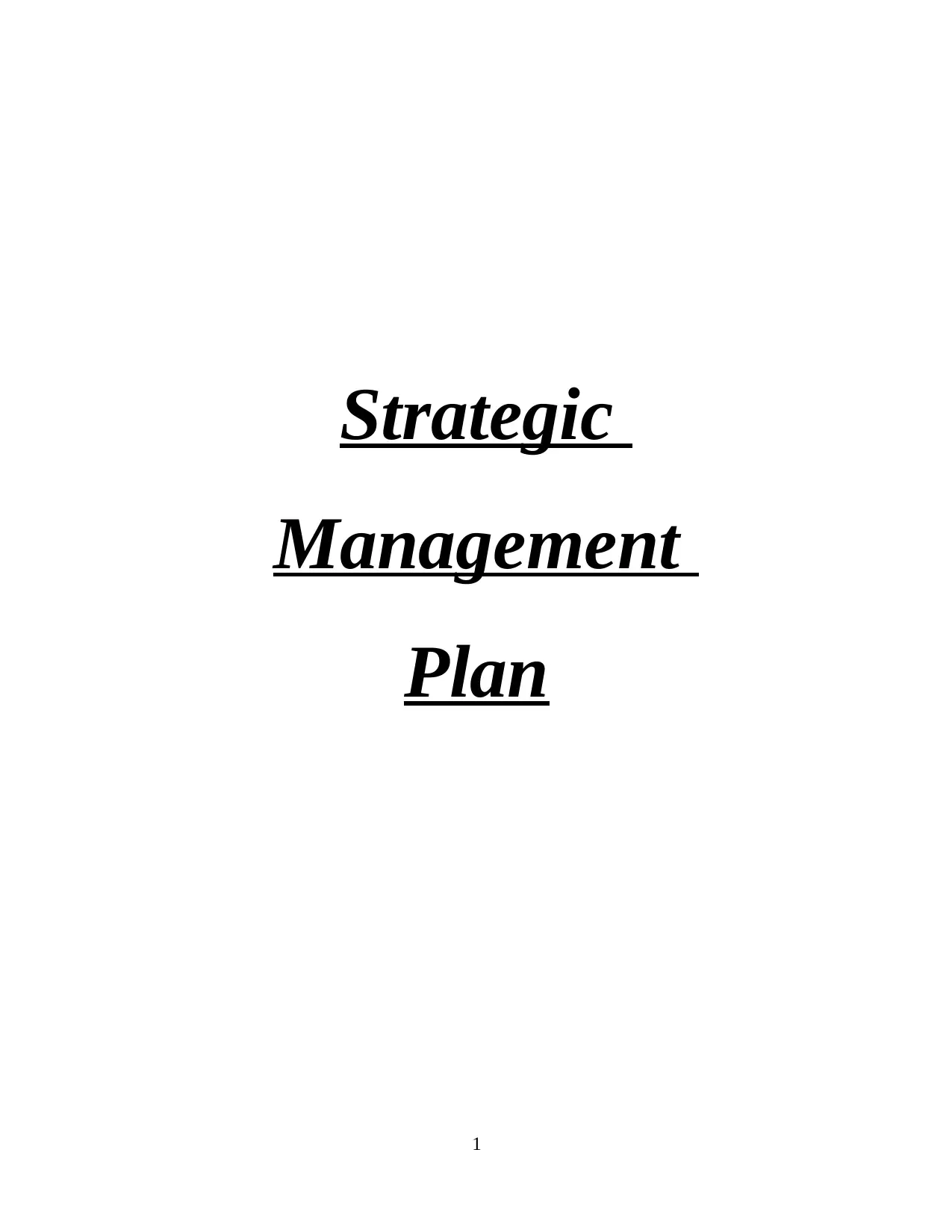
Strategic
Management
Plan
1
Management
Plan
1
Secure Best Marks with AI Grader
Need help grading? Try our AI Grader for instant feedback on your assignments.
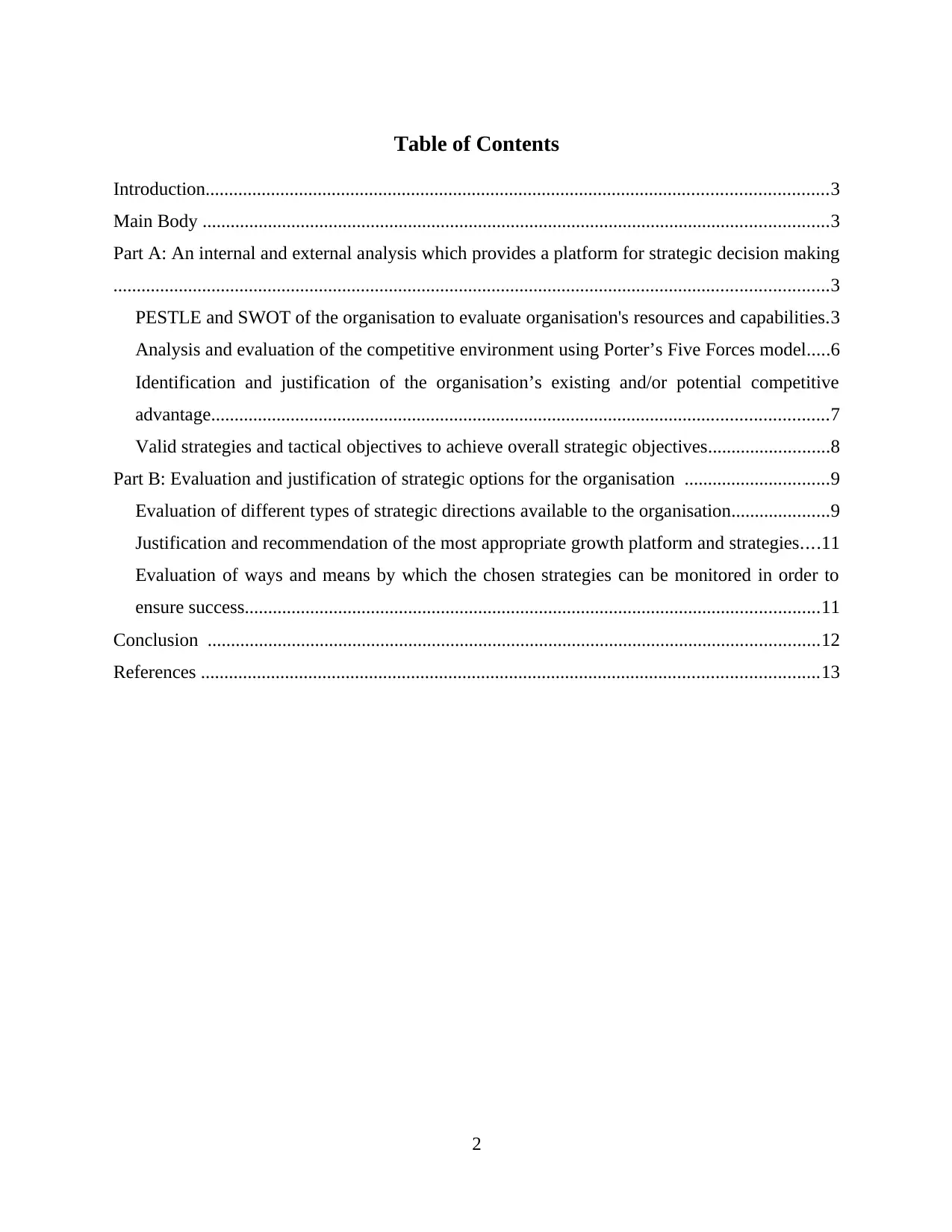
Table of Contents
Introduction.....................................................................................................................................3
Main Body ......................................................................................................................................3
Part A: An internal and external analysis which provides a platform for strategic decision making
.........................................................................................................................................................3
PESTLE and SWOT of the organisation to evaluate organisation's resources and capabilities.3
Analysis and evaluation of the competitive environment using Porter’s Five Forces model.....6
Identification and justification of the organisation’s existing and/or potential competitive
advantage....................................................................................................................................7
Valid strategies and tactical objectives to achieve overall strategic objectives..........................8
Part B: Evaluation and justification of strategic options for the organisation ...............................9
Evaluation of different types of strategic directions available to the organisation.....................9
Justification and recommendation of the most appropriate growth platform and strategies....11
Evaluation of ways and means by which the chosen strategies can be monitored in order to
ensure success...........................................................................................................................11
Conclusion ...................................................................................................................................12
References ....................................................................................................................................13
2
Introduction.....................................................................................................................................3
Main Body ......................................................................................................................................3
Part A: An internal and external analysis which provides a platform for strategic decision making
.........................................................................................................................................................3
PESTLE and SWOT of the organisation to evaluate organisation's resources and capabilities.3
Analysis and evaluation of the competitive environment using Porter’s Five Forces model.....6
Identification and justification of the organisation’s existing and/or potential competitive
advantage....................................................................................................................................7
Valid strategies and tactical objectives to achieve overall strategic objectives..........................8
Part B: Evaluation and justification of strategic options for the organisation ...............................9
Evaluation of different types of strategic directions available to the organisation.....................9
Justification and recommendation of the most appropriate growth platform and strategies....11
Evaluation of ways and means by which the chosen strategies can be monitored in order to
ensure success...........................................................................................................................11
Conclusion ...................................................................................................................................12
References ....................................................................................................................................13
2
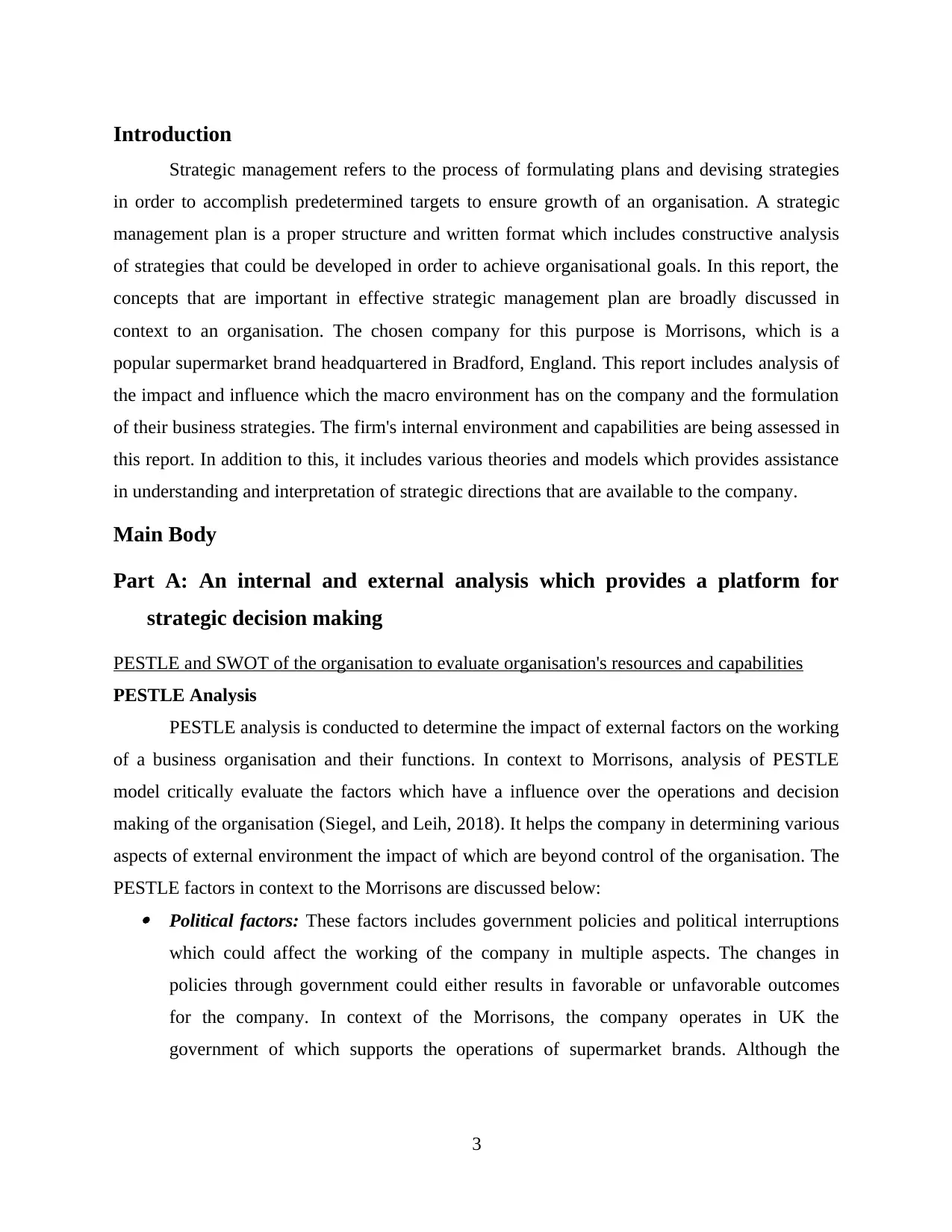
Introduction
Strategic management refers to the process of formulating plans and devising strategies
in order to accomplish predetermined targets to ensure growth of an organisation. A strategic
management plan is a proper structure and written format which includes constructive analysis
of strategies that could be developed in order to achieve organisational goals. In this report, the
concepts that are important in effective strategic management plan are broadly discussed in
context to an organisation. The chosen company for this purpose is Morrisons, which is a
popular supermarket brand headquartered in Bradford, England. This report includes analysis of
the impact and influence which the macro environment has on the company and the formulation
of their business strategies. The firm's internal environment and capabilities are being assessed in
this report. In addition to this, it includes various theories and models which provides assistance
in understanding and interpretation of strategic directions that are available to the company.
Main Body
Part A: An internal and external analysis which provides a platform for
strategic decision making
PESTLE and SWOT of the organisation to evaluate organisation's resources and capabilities
PESTLE Analysis
PESTLE analysis is conducted to determine the impact of external factors on the working
of a business organisation and their functions. In context to Morrisons, analysis of PESTLE
model critically evaluate the factors which have a influence over the operations and decision
making of the organisation (Siegel, and Leih, 2018). It helps the company in determining various
aspects of external environment the impact of which are beyond control of the organisation. The
PESTLE factors in context to the Morrisons are discussed below: Political factors: These factors includes government policies and political interruptions
which could affect the working of the company in multiple aspects. The changes in
policies through government could either results in favorable or unfavorable outcomes
for the company. In context of the Morrisons, the company operates in UK the
government of which supports the operations of supermarket brands. Although the
3
Strategic management refers to the process of formulating plans and devising strategies
in order to accomplish predetermined targets to ensure growth of an organisation. A strategic
management plan is a proper structure and written format which includes constructive analysis
of strategies that could be developed in order to achieve organisational goals. In this report, the
concepts that are important in effective strategic management plan are broadly discussed in
context to an organisation. The chosen company for this purpose is Morrisons, which is a
popular supermarket brand headquartered in Bradford, England. This report includes analysis of
the impact and influence which the macro environment has on the company and the formulation
of their business strategies. The firm's internal environment and capabilities are being assessed in
this report. In addition to this, it includes various theories and models which provides assistance
in understanding and interpretation of strategic directions that are available to the company.
Main Body
Part A: An internal and external analysis which provides a platform for
strategic decision making
PESTLE and SWOT of the organisation to evaluate organisation's resources and capabilities
PESTLE Analysis
PESTLE analysis is conducted to determine the impact of external factors on the working
of a business organisation and their functions. In context to Morrisons, analysis of PESTLE
model critically evaluate the factors which have a influence over the operations and decision
making of the organisation (Siegel, and Leih, 2018). It helps the company in determining various
aspects of external environment the impact of which are beyond control of the organisation. The
PESTLE factors in context to the Morrisons are discussed below: Political factors: These factors includes government policies and political interruptions
which could affect the working of the company in multiple aspects. The changes in
policies through government could either results in favorable or unfavorable outcomes
for the company. In context of the Morrisons, the company operates in UK the
government of which supports the operations of supermarket brands. Although the
3
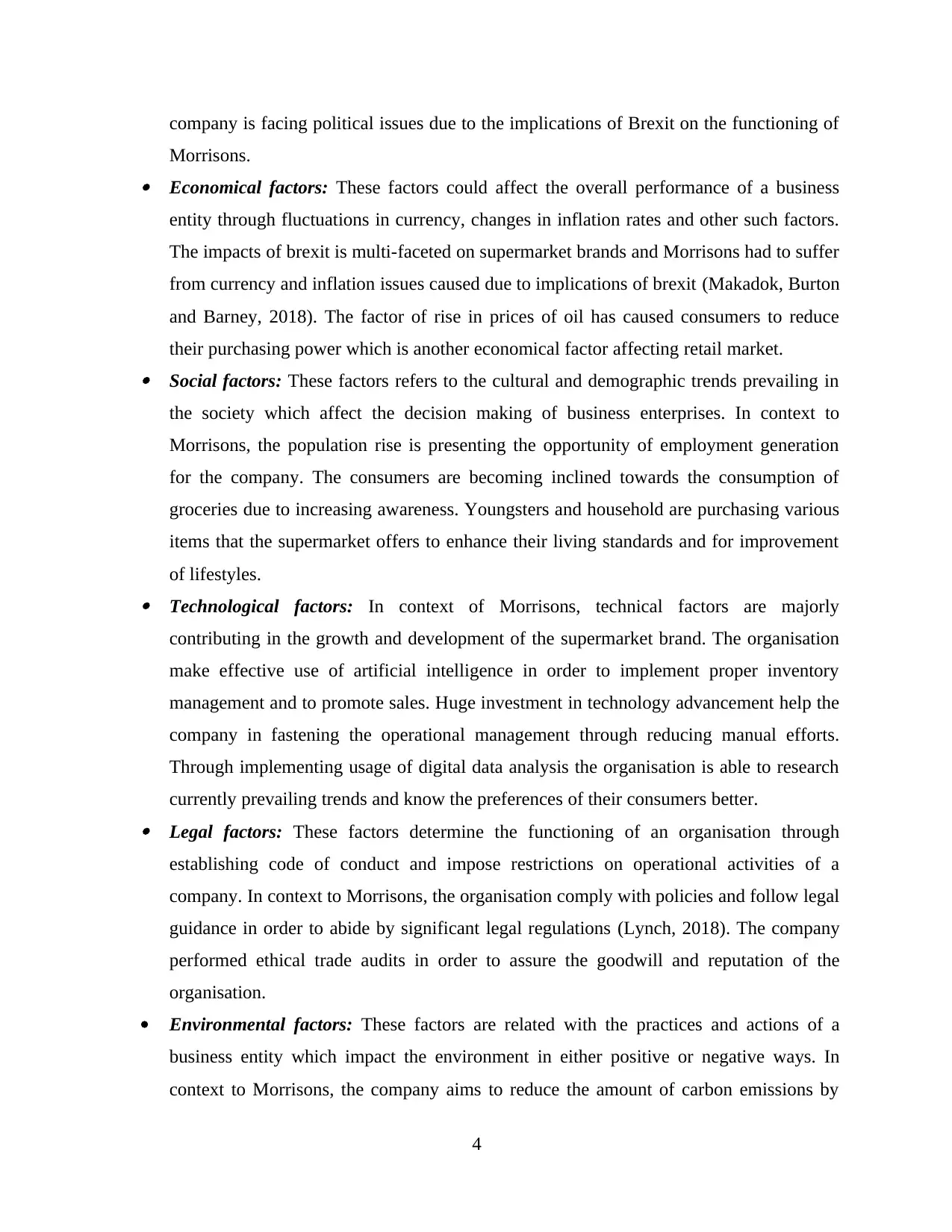
company is facing political issues due to the implications of Brexit on the functioning of
Morrisons. Economical factors: These factors could affect the overall performance of a business
entity through fluctuations in currency, changes in inflation rates and other such factors.
The impacts of brexit is multi-faceted on supermarket brands and Morrisons had to suffer
from currency and inflation issues caused due to implications of brexit (Makadok, Burton
and Barney, 2018). The factor of rise in prices of oil has caused consumers to reduce
their purchasing power which is another economical factor affecting retail market. Social factors: These factors refers to the cultural and demographic trends prevailing in
the society which affect the decision making of business enterprises. In context to
Morrisons, the population rise is presenting the opportunity of employment generation
for the company. The consumers are becoming inclined towards the consumption of
groceries due to increasing awareness. Youngsters and household are purchasing various
items that the supermarket offers to enhance their living standards and for improvement
of lifestyles. Technological factors: In context of Morrisons, technical factors are majorly
contributing in the growth and development of the supermarket brand. The organisation
make effective use of artificial intelligence in order to implement proper inventory
management and to promote sales. Huge investment in technology advancement help the
company in fastening the operational management through reducing manual efforts.
Through implementing usage of digital data analysis the organisation is able to research
currently prevailing trends and know the preferences of their consumers better. Legal factors: These factors determine the functioning of an organisation through
establishing code of conduct and impose restrictions on operational activities of a
company. In context to Morrisons, the organisation comply with policies and follow legal
guidance in order to abide by significant legal regulations (Lynch, 2018). The company
performed ethical trade audits in order to assure the goodwill and reputation of the
organisation.
Environmental factors: These factors are related with the practices and actions of a
business entity which impact the environment in either positive or negative ways. In
context to Morrisons, the company aims to reduce the amount of carbon emissions by
4
Morrisons. Economical factors: These factors could affect the overall performance of a business
entity through fluctuations in currency, changes in inflation rates and other such factors.
The impacts of brexit is multi-faceted on supermarket brands and Morrisons had to suffer
from currency and inflation issues caused due to implications of brexit (Makadok, Burton
and Barney, 2018). The factor of rise in prices of oil has caused consumers to reduce
their purchasing power which is another economical factor affecting retail market. Social factors: These factors refers to the cultural and demographic trends prevailing in
the society which affect the decision making of business enterprises. In context to
Morrisons, the population rise is presenting the opportunity of employment generation
for the company. The consumers are becoming inclined towards the consumption of
groceries due to increasing awareness. Youngsters and household are purchasing various
items that the supermarket offers to enhance their living standards and for improvement
of lifestyles. Technological factors: In context of Morrisons, technical factors are majorly
contributing in the growth and development of the supermarket brand. The organisation
make effective use of artificial intelligence in order to implement proper inventory
management and to promote sales. Huge investment in technology advancement help the
company in fastening the operational management through reducing manual efforts.
Through implementing usage of digital data analysis the organisation is able to research
currently prevailing trends and know the preferences of their consumers better. Legal factors: These factors determine the functioning of an organisation through
establishing code of conduct and impose restrictions on operational activities of a
company. In context to Morrisons, the organisation comply with policies and follow legal
guidance in order to abide by significant legal regulations (Lynch, 2018). The company
performed ethical trade audits in order to assure the goodwill and reputation of the
organisation.
Environmental factors: These factors are related with the practices and actions of a
business entity which impact the environment in either positive or negative ways. In
context to Morrisons, the company aims to reduce the amount of carbon emissions by
4
Secure Best Marks with AI Grader
Need help grading? Try our AI Grader for instant feedback on your assignments.
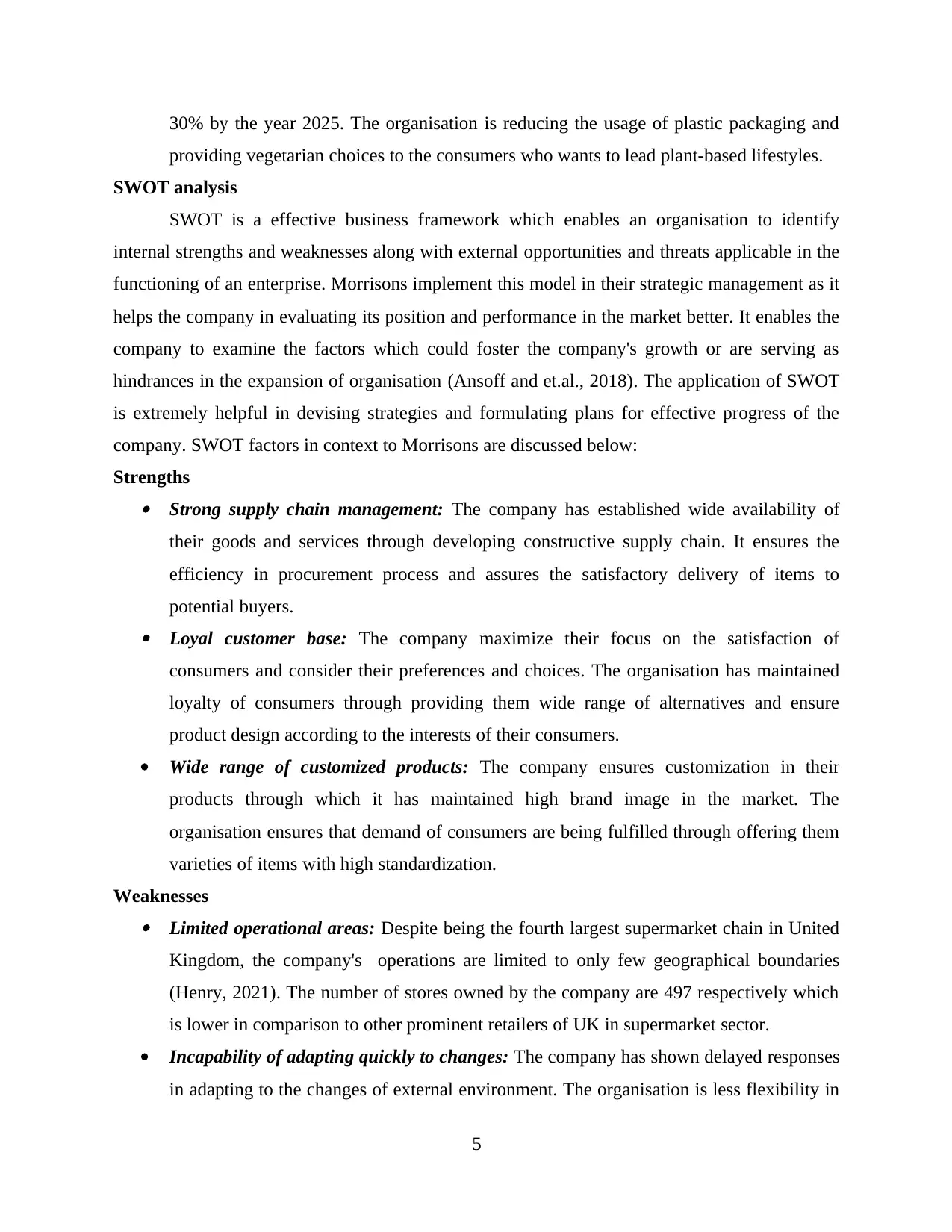
30% by the year 2025. The organisation is reducing the usage of plastic packaging and
providing vegetarian choices to the consumers who wants to lead plant-based lifestyles.
SWOT analysis
SWOT is a effective business framework which enables an organisation to identify
internal strengths and weaknesses along with external opportunities and threats applicable in the
functioning of an enterprise. Morrisons implement this model in their strategic management as it
helps the company in evaluating its position and performance in the market better. It enables the
company to examine the factors which could foster the company's growth or are serving as
hindrances in the expansion of organisation (Ansoff and et.al., 2018). The application of SWOT
is extremely helpful in devising strategies and formulating plans for effective progress of the
company. SWOT factors in context to Morrisons are discussed below:
Strengths Strong supply chain management: The company has established wide availability of
their goods and services through developing constructive supply chain. It ensures the
efficiency in procurement process and assures the satisfactory delivery of items to
potential buyers. Loyal customer base: The company maximize their focus on the satisfaction of
consumers and consider their preferences and choices. The organisation has maintained
loyalty of consumers through providing them wide range of alternatives and ensure
product design according to the interests of their consumers.
Wide range of customized products: The company ensures customization in their
products through which it has maintained high brand image in the market. The
organisation ensures that demand of consumers are being fulfilled through offering them
varieties of items with high standardization.
Weaknesses Limited operational areas: Despite being the fourth largest supermarket chain in United
Kingdom, the company's operations are limited to only few geographical boundaries
(Henry, 2021). The number of stores owned by the company are 497 respectively which
is lower in comparison to other prominent retailers of UK in supermarket sector.
Incapability of adapting quickly to changes: The company has shown delayed responses
in adapting to the changes of external environment. The organisation is less flexibility in
5
providing vegetarian choices to the consumers who wants to lead plant-based lifestyles.
SWOT analysis
SWOT is a effective business framework which enables an organisation to identify
internal strengths and weaknesses along with external opportunities and threats applicable in the
functioning of an enterprise. Morrisons implement this model in their strategic management as it
helps the company in evaluating its position and performance in the market better. It enables the
company to examine the factors which could foster the company's growth or are serving as
hindrances in the expansion of organisation (Ansoff and et.al., 2018). The application of SWOT
is extremely helpful in devising strategies and formulating plans for effective progress of the
company. SWOT factors in context to Morrisons are discussed below:
Strengths Strong supply chain management: The company has established wide availability of
their goods and services through developing constructive supply chain. It ensures the
efficiency in procurement process and assures the satisfactory delivery of items to
potential buyers. Loyal customer base: The company maximize their focus on the satisfaction of
consumers and consider their preferences and choices. The organisation has maintained
loyalty of consumers through providing them wide range of alternatives and ensure
product design according to the interests of their consumers.
Wide range of customized products: The company ensures customization in their
products through which it has maintained high brand image in the market. The
organisation ensures that demand of consumers are being fulfilled through offering them
varieties of items with high standardization.
Weaknesses Limited operational areas: Despite being the fourth largest supermarket chain in United
Kingdom, the company's operations are limited to only few geographical boundaries
(Henry, 2021). The number of stores owned by the company are 497 respectively which
is lower in comparison to other prominent retailers of UK in supermarket sector.
Incapability of adapting quickly to changes: The company has shown delayed responses
in adapting to the changes of external environment. The organisation is less flexibility in
5
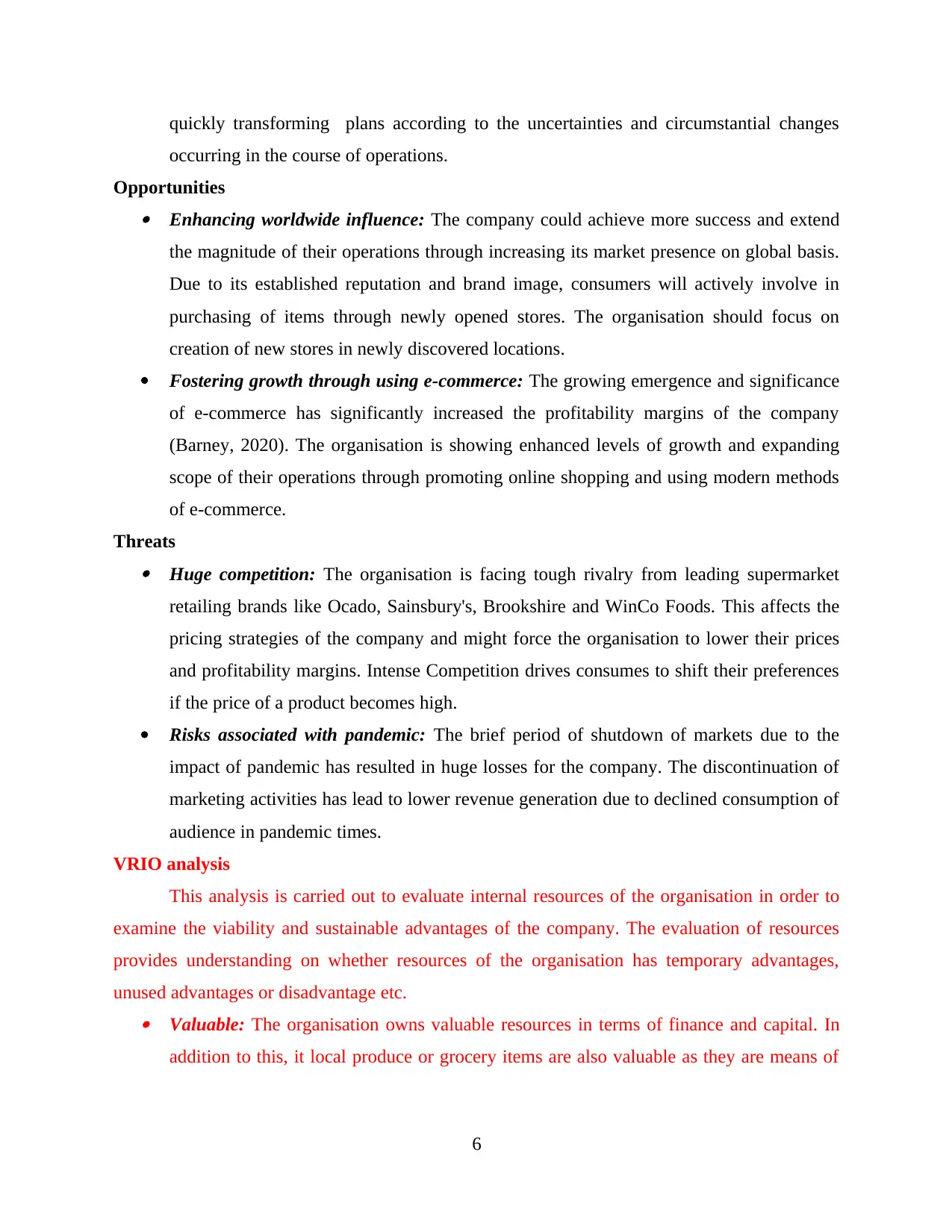
quickly transforming plans according to the uncertainties and circumstantial changes
occurring in the course of operations.
Opportunities Enhancing worldwide influence: The company could achieve more success and extend
the magnitude of their operations through increasing its market presence on global basis.
Due to its established reputation and brand image, consumers will actively involve in
purchasing of items through newly opened stores. The organisation should focus on
creation of new stores in newly discovered locations.
Fostering growth through using e-commerce: The growing emergence and significance
of e-commerce has significantly increased the profitability margins of the company
(Barney, 2020). The organisation is showing enhanced levels of growth and expanding
scope of their operations through promoting online shopping and using modern methods
of e-commerce.
Threats Huge competition: The organisation is facing tough rivalry from leading supermarket
retailing brands like Ocado, Sainsbury's, Brookshire and WinCo Foods. This affects the
pricing strategies of the company and might force the organisation to lower their prices
and profitability margins. Intense Competition drives consumes to shift their preferences
if the price of a product becomes high.
Risks associated with pandemic: The brief period of shutdown of markets due to the
impact of pandemic has resulted in huge losses for the company. The discontinuation of
marketing activities has lead to lower revenue generation due to declined consumption of
audience in pandemic times.
VRIO analysis
This analysis is carried out to evaluate internal resources of the organisation in order to
examine the viability and sustainable advantages of the company. The evaluation of resources
provides understanding on whether resources of the organisation has temporary advantages,
unused advantages or disadvantage etc. Valuable: The organisation owns valuable resources in terms of finance and capital. In
addition to this, it local produce or grocery items are also valuable as they are means of
6
occurring in the course of operations.
Opportunities Enhancing worldwide influence: The company could achieve more success and extend
the magnitude of their operations through increasing its market presence on global basis.
Due to its established reputation and brand image, consumers will actively involve in
purchasing of items through newly opened stores. The organisation should focus on
creation of new stores in newly discovered locations.
Fostering growth through using e-commerce: The growing emergence and significance
of e-commerce has significantly increased the profitability margins of the company
(Barney, 2020). The organisation is showing enhanced levels of growth and expanding
scope of their operations through promoting online shopping and using modern methods
of e-commerce.
Threats Huge competition: The organisation is facing tough rivalry from leading supermarket
retailing brands like Ocado, Sainsbury's, Brookshire and WinCo Foods. This affects the
pricing strategies of the company and might force the organisation to lower their prices
and profitability margins. Intense Competition drives consumes to shift their preferences
if the price of a product becomes high.
Risks associated with pandemic: The brief period of shutdown of markets due to the
impact of pandemic has resulted in huge losses for the company. The discontinuation of
marketing activities has lead to lower revenue generation due to declined consumption of
audience in pandemic times.
VRIO analysis
This analysis is carried out to evaluate internal resources of the organisation in order to
examine the viability and sustainable advantages of the company. The evaluation of resources
provides understanding on whether resources of the organisation has temporary advantages,
unused advantages or disadvantage etc. Valuable: The organisation owns valuable resources in terms of finance and capital. In
addition to this, it local produce or grocery items are also valuable as they are means of
6
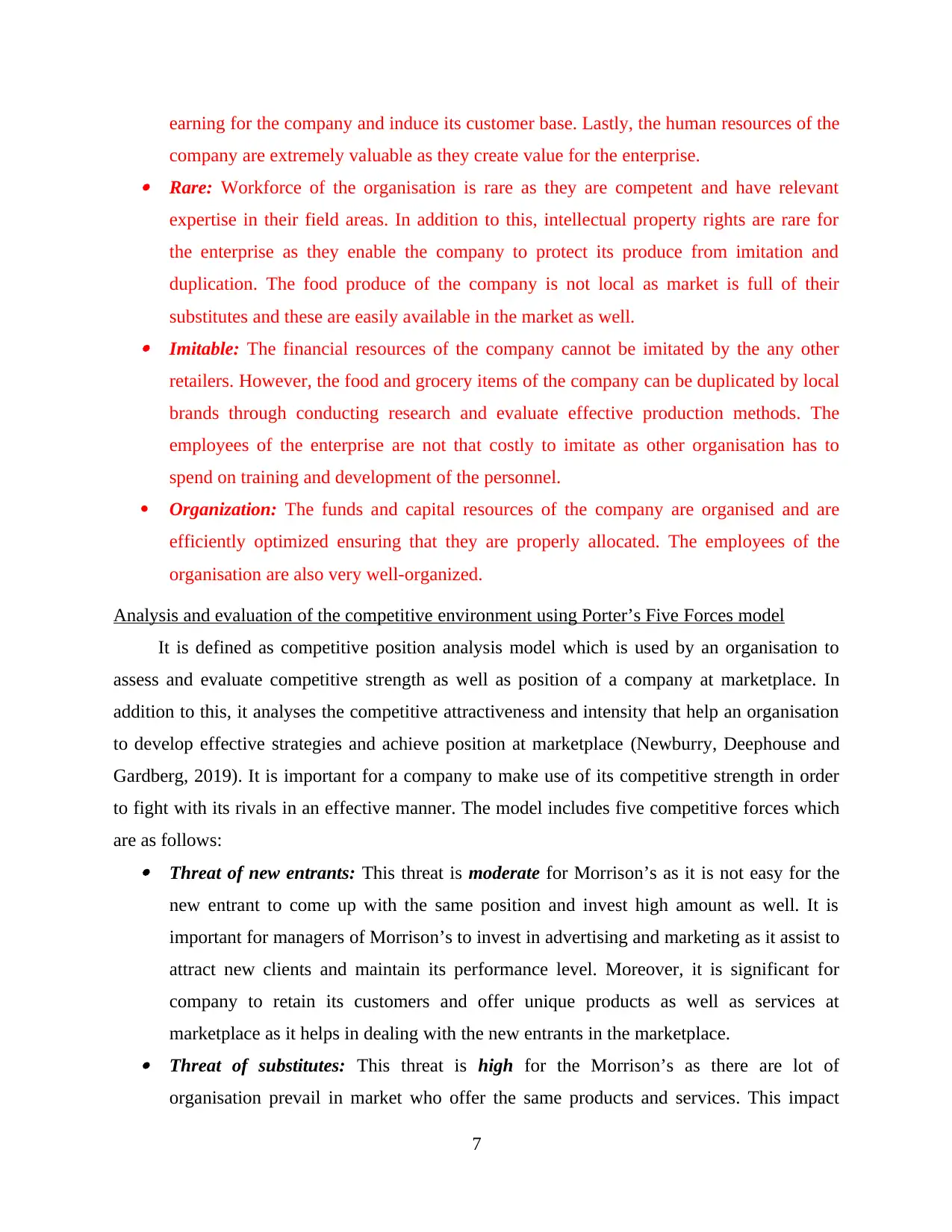
earning for the company and induce its customer base. Lastly, the human resources of the
company are extremely valuable as they create value for the enterprise. Rare: Workforce of the organisation is rare as they are competent and have relevant
expertise in their field areas. In addition to this, intellectual property rights are rare for
the enterprise as they enable the company to protect its produce from imitation and
duplication. The food produce of the company is not local as market is full of their
substitutes and these are easily available in the market as well. Imitable: The financial resources of the company cannot be imitated by the any other
retailers. However, the food and grocery items of the company can be duplicated by local
brands through conducting research and evaluate effective production methods. The
employees of the enterprise are not that costly to imitate as other organisation has to
spend on training and development of the personnel.
Organization: The funds and capital resources of the company are organised and are
efficiently optimized ensuring that they are properly allocated. The employees of the
organisation are also very well-organized.
Analysis and evaluation of the competitive environment using Porter’s Five Forces model
It is defined as competitive position analysis model which is used by an organisation to
assess and evaluate competitive strength as well as position of a company at marketplace. In
addition to this, it analyses the competitive attractiveness and intensity that help an organisation
to develop effective strategies and achieve position at marketplace (Newburry, Deephouse and
Gardberg, 2019). It is important for a company to make use of its competitive strength in order
to fight with its rivals in an effective manner. The model includes five competitive forces which
are as follows: Threat of new entrants: This threat is moderate for Morrison’s as it is not easy for the
new entrant to come up with the same position and invest high amount as well. It is
important for managers of Morrison’s to invest in advertising and marketing as it assist to
attract new clients and maintain its performance level. Moreover, it is significant for
company to retain its customers and offer unique products as well as services at
marketplace as it helps in dealing with the new entrants in the marketplace. Threat of substitutes: This threat is high for the Morrison’s as there are lot of
organisation prevail in market who offer the same products and services. This impact
7
company are extremely valuable as they create value for the enterprise. Rare: Workforce of the organisation is rare as they are competent and have relevant
expertise in their field areas. In addition to this, intellectual property rights are rare for
the enterprise as they enable the company to protect its produce from imitation and
duplication. The food produce of the company is not local as market is full of their
substitutes and these are easily available in the market as well. Imitable: The financial resources of the company cannot be imitated by the any other
retailers. However, the food and grocery items of the company can be duplicated by local
brands through conducting research and evaluate effective production methods. The
employees of the enterprise are not that costly to imitate as other organisation has to
spend on training and development of the personnel.
Organization: The funds and capital resources of the company are organised and are
efficiently optimized ensuring that they are properly allocated. The employees of the
organisation are also very well-organized.
Analysis and evaluation of the competitive environment using Porter’s Five Forces model
It is defined as competitive position analysis model which is used by an organisation to
assess and evaluate competitive strength as well as position of a company at marketplace. In
addition to this, it analyses the competitive attractiveness and intensity that help an organisation
to develop effective strategies and achieve position at marketplace (Newburry, Deephouse and
Gardberg, 2019). It is important for a company to make use of its competitive strength in order
to fight with its rivals in an effective manner. The model includes five competitive forces which
are as follows: Threat of new entrants: This threat is moderate for Morrison’s as it is not easy for the
new entrant to come up with the same position and invest high amount as well. It is
important for managers of Morrison’s to invest in advertising and marketing as it assist to
attract new clients and maintain its performance level. Moreover, it is significant for
company to retain its customers and offer unique products as well as services at
marketplace as it helps in dealing with the new entrants in the marketplace. Threat of substitutes: This threat is high for the Morrison’s as there are lot of
organisation prevail in market who offer the same products and services. This impact
7
Paraphrase This Document
Need a fresh take? Get an instant paraphrase of this document with our AI Paraphraser
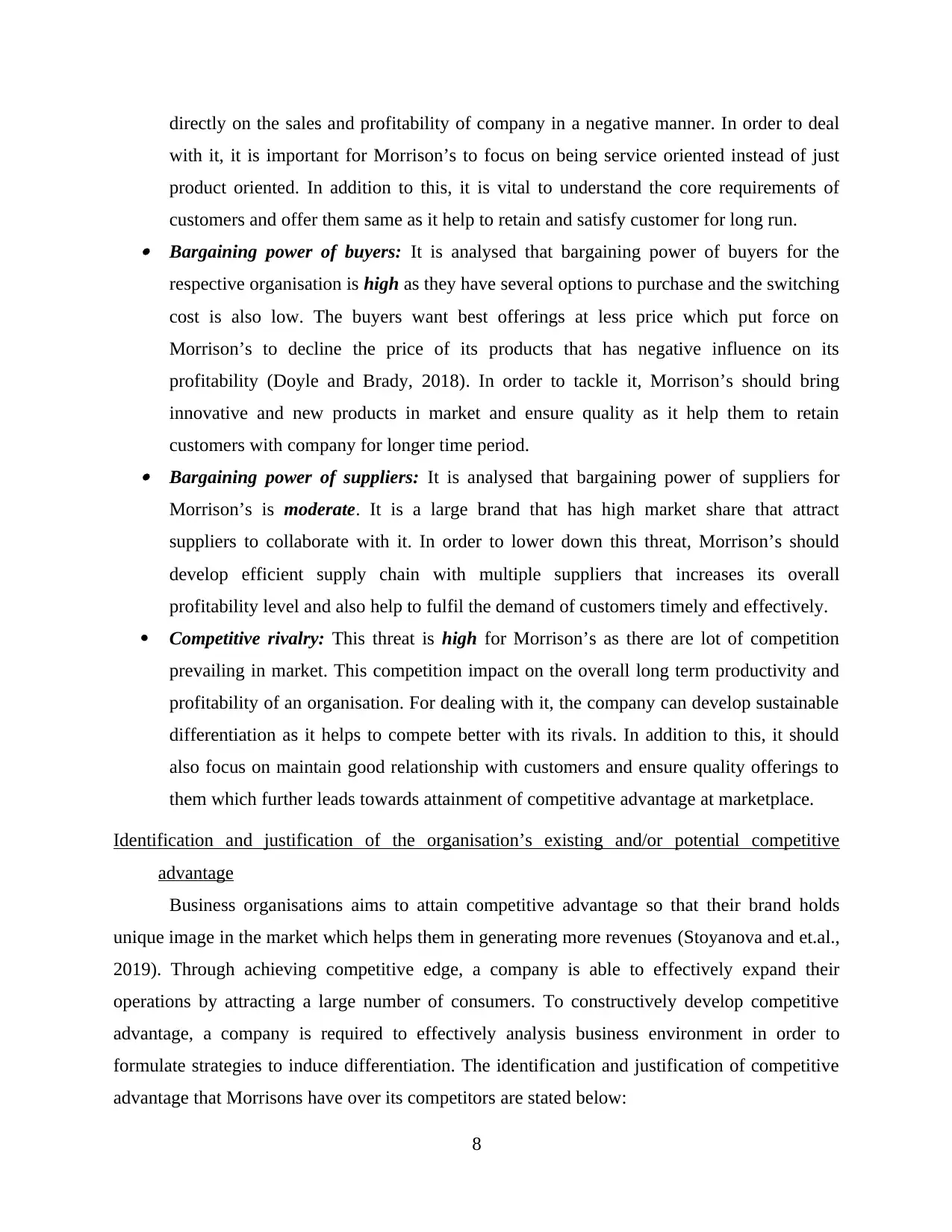
directly on the sales and profitability of company in a negative manner. In order to deal
with it, it is important for Morrison’s to focus on being service oriented instead of just
product oriented. In addition to this, it is vital to understand the core requirements of
customers and offer them same as it help to retain and satisfy customer for long run. Bargaining power of buyers: It is analysed that bargaining power of buyers for the
respective organisation is high as they have several options to purchase and the switching
cost is also low. The buyers want best offerings at less price which put force on
Morrison’s to decline the price of its products that has negative influence on its
profitability (Doyle and Brady, 2018). In order to tackle it, Morrison’s should bring
innovative and new products in market and ensure quality as it help them to retain
customers with company for longer time period. Bargaining power of suppliers: It is analysed that bargaining power of suppliers for
Morrison’s is moderate. It is a large brand that has high market share that attract
suppliers to collaborate with it. In order to lower down this threat, Morrison’s should
develop efficient supply chain with multiple suppliers that increases its overall
profitability level and also help to fulfil the demand of customers timely and effectively.
Competitive rivalry: This threat is high for Morrison’s as there are lot of competition
prevailing in market. This competition impact on the overall long term productivity and
profitability of an organisation. For dealing with it, the company can develop sustainable
differentiation as it helps to compete better with its rivals. In addition to this, it should
also focus on maintain good relationship with customers and ensure quality offerings to
them which further leads towards attainment of competitive advantage at marketplace.
Identification and justification of the organisation’s existing and/or potential competitive
advantage
Business organisations aims to attain competitive advantage so that their brand holds
unique image in the market which helps them in generating more revenues (Stoyanova and et.al.,
2019). Through achieving competitive edge, a company is able to effectively expand their
operations by attracting a large number of consumers. To constructively develop competitive
advantage, a company is required to effectively analysis business environment in order to
formulate strategies to induce differentiation. The identification and justification of competitive
advantage that Morrisons have over its competitors are stated below:
8
with it, it is important for Morrison’s to focus on being service oriented instead of just
product oriented. In addition to this, it is vital to understand the core requirements of
customers and offer them same as it help to retain and satisfy customer for long run. Bargaining power of buyers: It is analysed that bargaining power of buyers for the
respective organisation is high as they have several options to purchase and the switching
cost is also low. The buyers want best offerings at less price which put force on
Morrison’s to decline the price of its products that has negative influence on its
profitability (Doyle and Brady, 2018). In order to tackle it, Morrison’s should bring
innovative and new products in market and ensure quality as it help them to retain
customers with company for longer time period. Bargaining power of suppliers: It is analysed that bargaining power of suppliers for
Morrison’s is moderate. It is a large brand that has high market share that attract
suppliers to collaborate with it. In order to lower down this threat, Morrison’s should
develop efficient supply chain with multiple suppliers that increases its overall
profitability level and also help to fulfil the demand of customers timely and effectively.
Competitive rivalry: This threat is high for Morrison’s as there are lot of competition
prevailing in market. This competition impact on the overall long term productivity and
profitability of an organisation. For dealing with it, the company can develop sustainable
differentiation as it helps to compete better with its rivals. In addition to this, it should
also focus on maintain good relationship with customers and ensure quality offerings to
them which further leads towards attainment of competitive advantage at marketplace.
Identification and justification of the organisation’s existing and/or potential competitive
advantage
Business organisations aims to attain competitive advantage so that their brand holds
unique image in the market which helps them in generating more revenues (Stoyanova and et.al.,
2019). Through achieving competitive edge, a company is able to effectively expand their
operations by attracting a large number of consumers. To constructively develop competitive
advantage, a company is required to effectively analysis business environment in order to
formulate strategies to induce differentiation. The identification and justification of competitive
advantage that Morrisons have over its competitors are stated below:
8
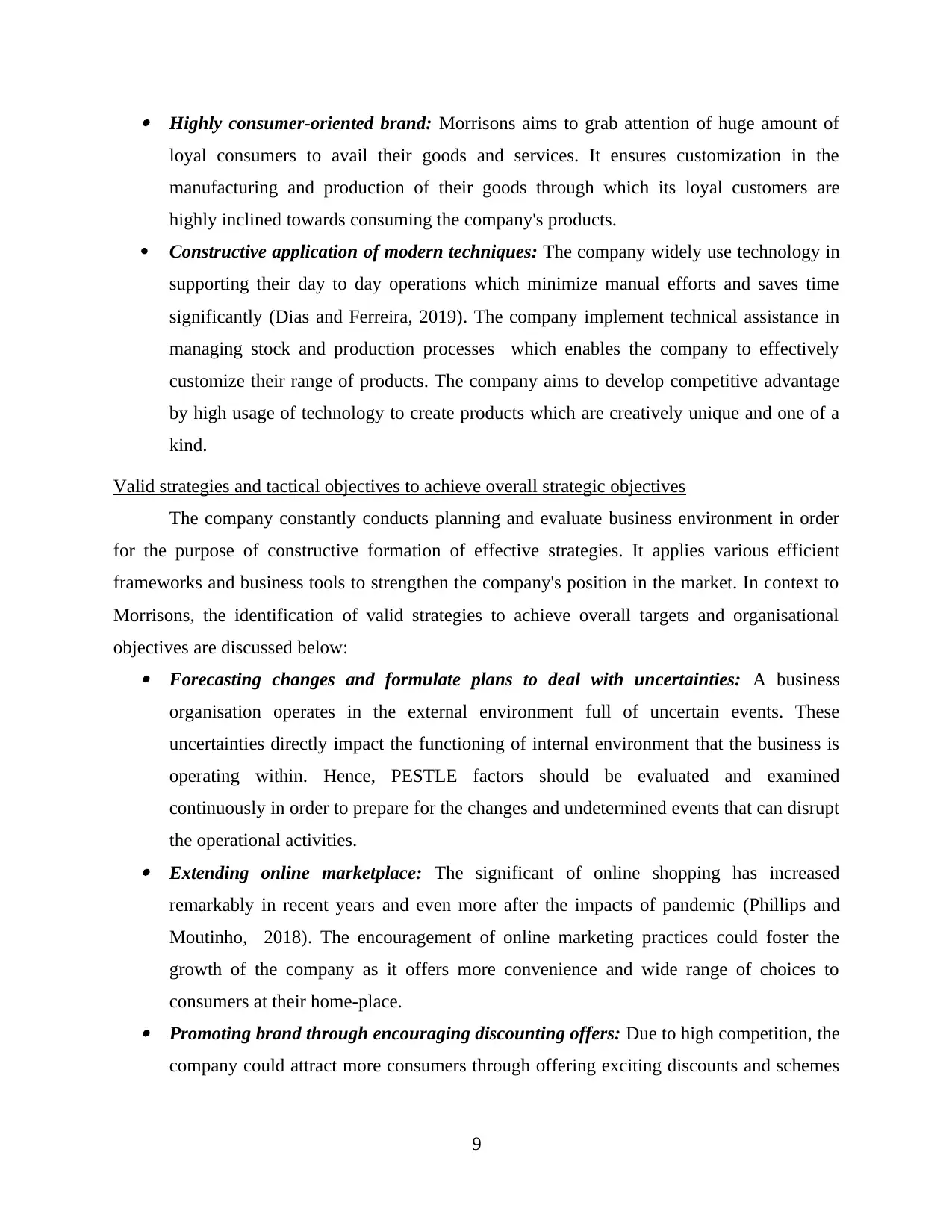
Highly consumer-oriented brand: Morrisons aims to grab attention of huge amount of
loyal consumers to avail their goods and services. It ensures customization in the
manufacturing and production of their goods through which its loyal customers are
highly inclined towards consuming the company's products.
Constructive application of modern techniques: The company widely use technology in
supporting their day to day operations which minimize manual efforts and saves time
significantly (Dias and Ferreira, 2019). The company implement technical assistance in
managing stock and production processes which enables the company to effectively
customize their range of products. The company aims to develop competitive advantage
by high usage of technology to create products which are creatively unique and one of a
kind.
Valid strategies and tactical objectives to achieve overall strategic objectives
The company constantly conducts planning and evaluate business environment in order
for the purpose of constructive formation of effective strategies. It applies various efficient
frameworks and business tools to strengthen the company's position in the market. In context to
Morrisons, the identification of valid strategies to achieve overall targets and organisational
objectives are discussed below: Forecasting changes and formulate plans to deal with uncertainties: A business
organisation operates in the external environment full of uncertain events. These
uncertainties directly impact the functioning of internal environment that the business is
operating within. Hence, PESTLE factors should be evaluated and examined
continuously in order to prepare for the changes and undetermined events that can disrupt
the operational activities. Extending online marketplace: The significant of online shopping has increased
remarkably in recent years and even more after the impacts of pandemic (Phillips and
Moutinho, 2018). The encouragement of online marketing practices could foster the
growth of the company as it offers more convenience and wide range of choices to
consumers at their home-place. Promoting brand through encouraging discounting offers: Due to high competition, the
company could attract more consumers through offering exciting discounts and schemes
9
loyal consumers to avail their goods and services. It ensures customization in the
manufacturing and production of their goods through which its loyal customers are
highly inclined towards consuming the company's products.
Constructive application of modern techniques: The company widely use technology in
supporting their day to day operations which minimize manual efforts and saves time
significantly (Dias and Ferreira, 2019). The company implement technical assistance in
managing stock and production processes which enables the company to effectively
customize their range of products. The company aims to develop competitive advantage
by high usage of technology to create products which are creatively unique and one of a
kind.
Valid strategies and tactical objectives to achieve overall strategic objectives
The company constantly conducts planning and evaluate business environment in order
for the purpose of constructive formation of effective strategies. It applies various efficient
frameworks and business tools to strengthen the company's position in the market. In context to
Morrisons, the identification of valid strategies to achieve overall targets and organisational
objectives are discussed below: Forecasting changes and formulate plans to deal with uncertainties: A business
organisation operates in the external environment full of uncertain events. These
uncertainties directly impact the functioning of internal environment that the business is
operating within. Hence, PESTLE factors should be evaluated and examined
continuously in order to prepare for the changes and undetermined events that can disrupt
the operational activities. Extending online marketplace: The significant of online shopping has increased
remarkably in recent years and even more after the impacts of pandemic (Phillips and
Moutinho, 2018). The encouragement of online marketing practices could foster the
growth of the company as it offers more convenience and wide range of choices to
consumers at their home-place. Promoting brand through encouraging discounting offers: Due to high competition, the
company could attract more consumers through offering exciting discounts and schemes
9
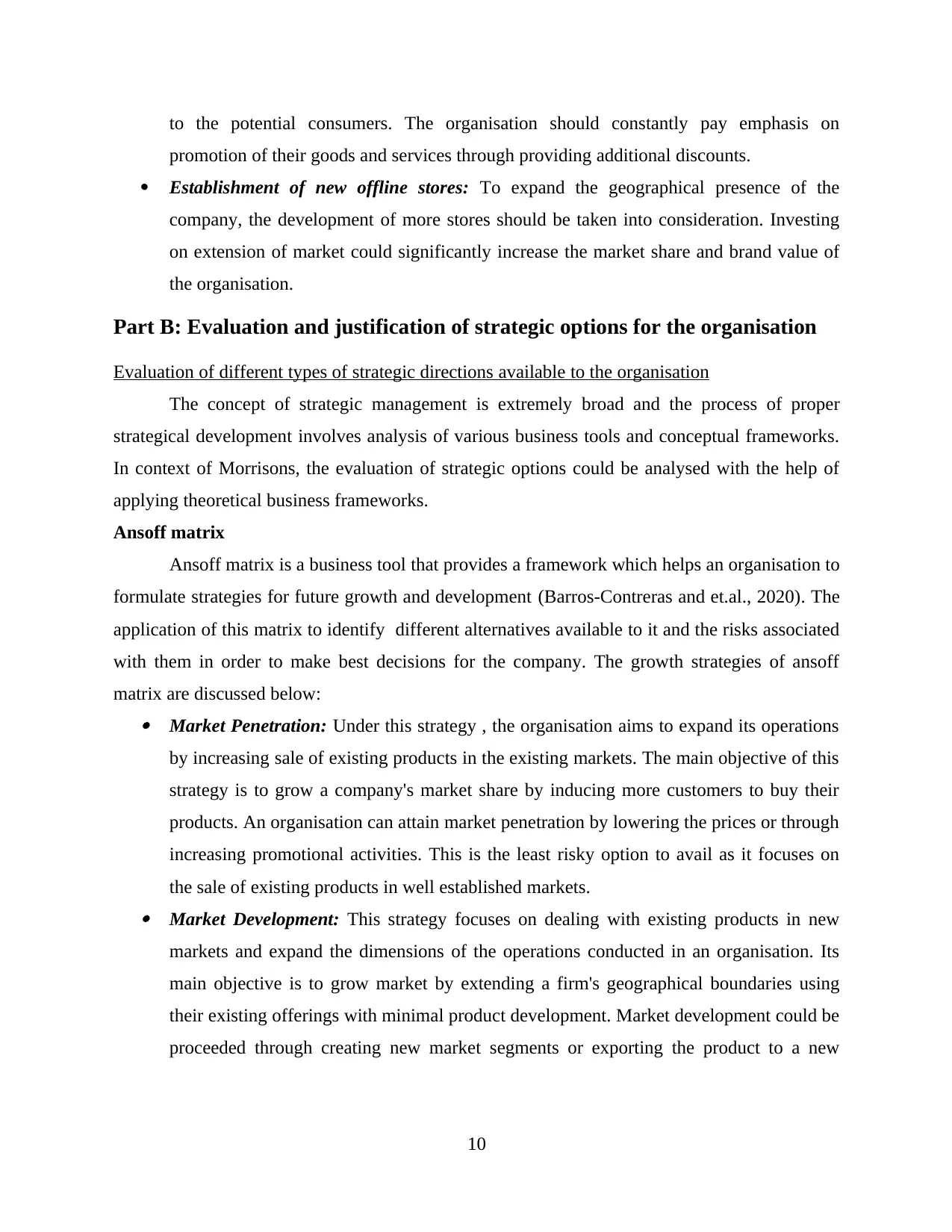
to the potential consumers. The organisation should constantly pay emphasis on
promotion of their goods and services through providing additional discounts.
Establishment of new offline stores: To expand the geographical presence of the
company, the development of more stores should be taken into consideration. Investing
on extension of market could significantly increase the market share and brand value of
the organisation.
Part B: Evaluation and justification of strategic options for the organisation
Evaluation of different types of strategic directions available to the organisation
The concept of strategic management is extremely broad and the process of proper
strategical development involves analysis of various business tools and conceptual frameworks.
In context of Morrisons, the evaluation of strategic options could be analysed with the help of
applying theoretical business frameworks.
Ansoff matrix
Ansoff matrix is a business tool that provides a framework which helps an organisation to
formulate strategies for future growth and development (Barros-Contreras and et.al., 2020). The
application of this matrix to identify different alternatives available to it and the risks associated
with them in order to make best decisions for the company. The growth strategies of ansoff
matrix are discussed below: Market Penetration: Under this strategy , the organisation aims to expand its operations
by increasing sale of existing products in the existing markets. The main objective of this
strategy is to grow a company's market share by inducing more customers to buy their
products. An organisation can attain market penetration by lowering the prices or through
increasing promotional activities. This is the least risky option to avail as it focuses on
the sale of existing products in well established markets. Market Development: This strategy focuses on dealing with existing products in new
markets and expand the dimensions of the operations conducted in an organisation. Its
main objective is to grow market by extending a firm's geographical boundaries using
their existing offerings with minimal product development. Market development could be
proceeded through creating new market segments or exporting the product to a new
10
promotion of their goods and services through providing additional discounts.
Establishment of new offline stores: To expand the geographical presence of the
company, the development of more stores should be taken into consideration. Investing
on extension of market could significantly increase the market share and brand value of
the organisation.
Part B: Evaluation and justification of strategic options for the organisation
Evaluation of different types of strategic directions available to the organisation
The concept of strategic management is extremely broad and the process of proper
strategical development involves analysis of various business tools and conceptual frameworks.
In context of Morrisons, the evaluation of strategic options could be analysed with the help of
applying theoretical business frameworks.
Ansoff matrix
Ansoff matrix is a business tool that provides a framework which helps an organisation to
formulate strategies for future growth and development (Barros-Contreras and et.al., 2020). The
application of this matrix to identify different alternatives available to it and the risks associated
with them in order to make best decisions for the company. The growth strategies of ansoff
matrix are discussed below: Market Penetration: Under this strategy , the organisation aims to expand its operations
by increasing sale of existing products in the existing markets. The main objective of this
strategy is to grow a company's market share by inducing more customers to buy their
products. An organisation can attain market penetration by lowering the prices or through
increasing promotional activities. This is the least risky option to avail as it focuses on
the sale of existing products in well established markets. Market Development: This strategy focuses on dealing with existing products in new
markets and expand the dimensions of the operations conducted in an organisation. Its
main objective is to grow market by extending a firm's geographical boundaries using
their existing offerings with minimal product development. Market development could be
proceeded through creating new market segments or exporting the product to a new
10
Secure Best Marks with AI Grader
Need help grading? Try our AI Grader for instant feedback on your assignments.
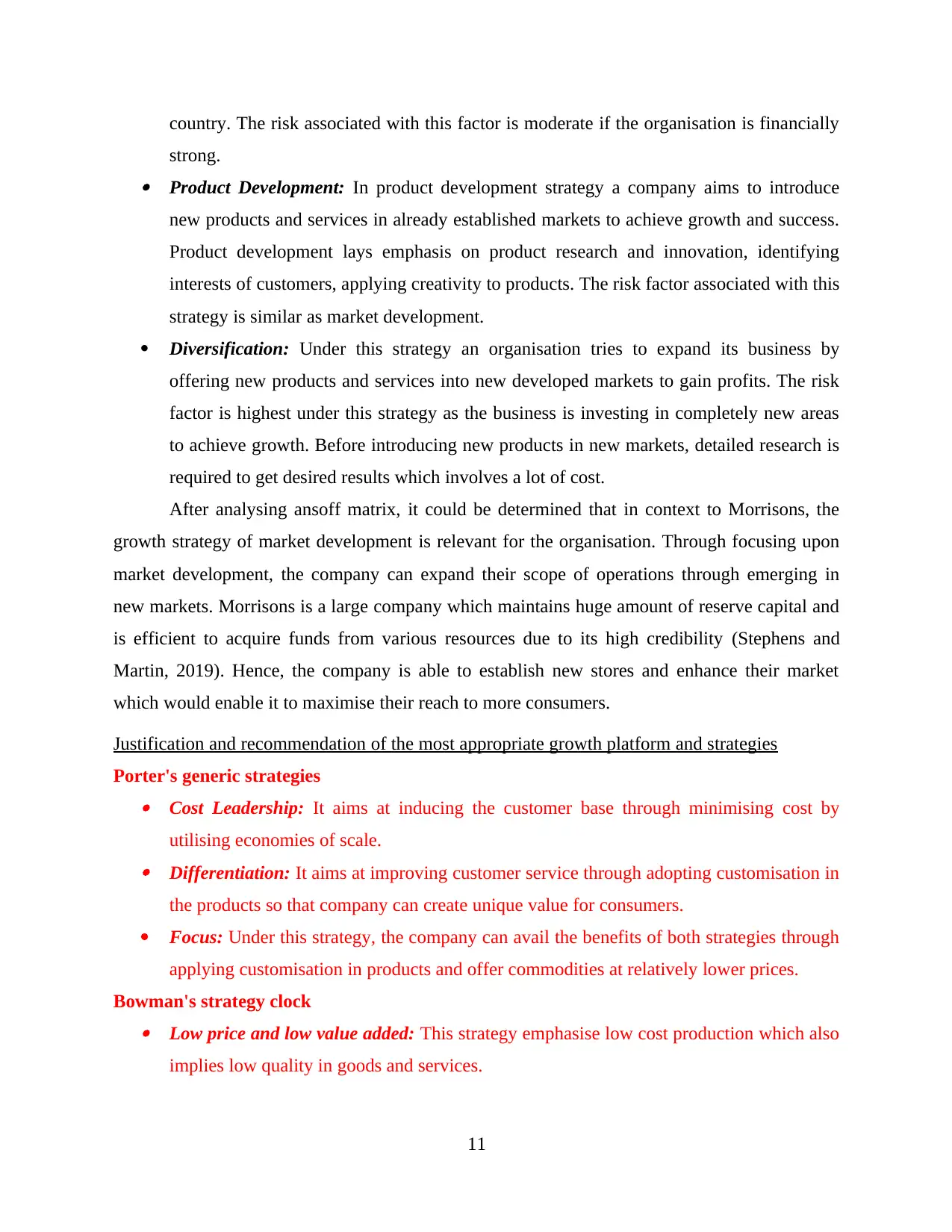
country. The risk associated with this factor is moderate if the organisation is financially
strong. Product Development: In product development strategy a company aims to introduce
new products and services in already established markets to achieve growth and success.
Product development lays emphasis on product research and innovation, identifying
interests of customers, applying creativity to products. The risk factor associated with this
strategy is similar as market development.
Diversification: Under this strategy an organisation tries to expand its business by
offering new products and services into new developed markets to gain profits. The risk
factor is highest under this strategy as the business is investing in completely new areas
to achieve growth. Before introducing new products in new markets, detailed research is
required to get desired results which involves a lot of cost.
After analysing ansoff matrix, it could be determined that in context to Morrisons, the
growth strategy of market development is relevant for the organisation. Through focusing upon
market development, the company can expand their scope of operations through emerging in
new markets. Morrisons is a large company which maintains huge amount of reserve capital and
is efficient to acquire funds from various resources due to its high credibility (Stephens and
Martin, 2019). Hence, the company is able to establish new stores and enhance their market
which would enable it to maximise their reach to more consumers.
Justification and recommendation of the most appropriate growth platform and strategies
Porter's generic strategies Cost Leadership: It aims at inducing the customer base through minimising cost by
utilising economies of scale. Differentiation: It aims at improving customer service through adopting customisation in
the products so that company can create unique value for consumers.
Focus: Under this strategy, the company can avail the benefits of both strategies through
applying customisation in products and offer commodities at relatively lower prices.
Bowman's strategy clock Low price and low value added: This strategy emphasise low cost production which also
implies low quality in goods and services.
11
strong. Product Development: In product development strategy a company aims to introduce
new products and services in already established markets to achieve growth and success.
Product development lays emphasis on product research and innovation, identifying
interests of customers, applying creativity to products. The risk factor associated with this
strategy is similar as market development.
Diversification: Under this strategy an organisation tries to expand its business by
offering new products and services into new developed markets to gain profits. The risk
factor is highest under this strategy as the business is investing in completely new areas
to achieve growth. Before introducing new products in new markets, detailed research is
required to get desired results which involves a lot of cost.
After analysing ansoff matrix, it could be determined that in context to Morrisons, the
growth strategy of market development is relevant for the organisation. Through focusing upon
market development, the company can expand their scope of operations through emerging in
new markets. Morrisons is a large company which maintains huge amount of reserve capital and
is efficient to acquire funds from various resources due to its high credibility (Stephens and
Martin, 2019). Hence, the company is able to establish new stores and enhance their market
which would enable it to maximise their reach to more consumers.
Justification and recommendation of the most appropriate growth platform and strategies
Porter's generic strategies Cost Leadership: It aims at inducing the customer base through minimising cost by
utilising economies of scale. Differentiation: It aims at improving customer service through adopting customisation in
the products so that company can create unique value for consumers.
Focus: Under this strategy, the company can avail the benefits of both strategies through
applying customisation in products and offer commodities at relatively lower prices.
Bowman's strategy clock Low price and low value added: This strategy emphasise low cost production which also
implies low quality in goods and services.
11
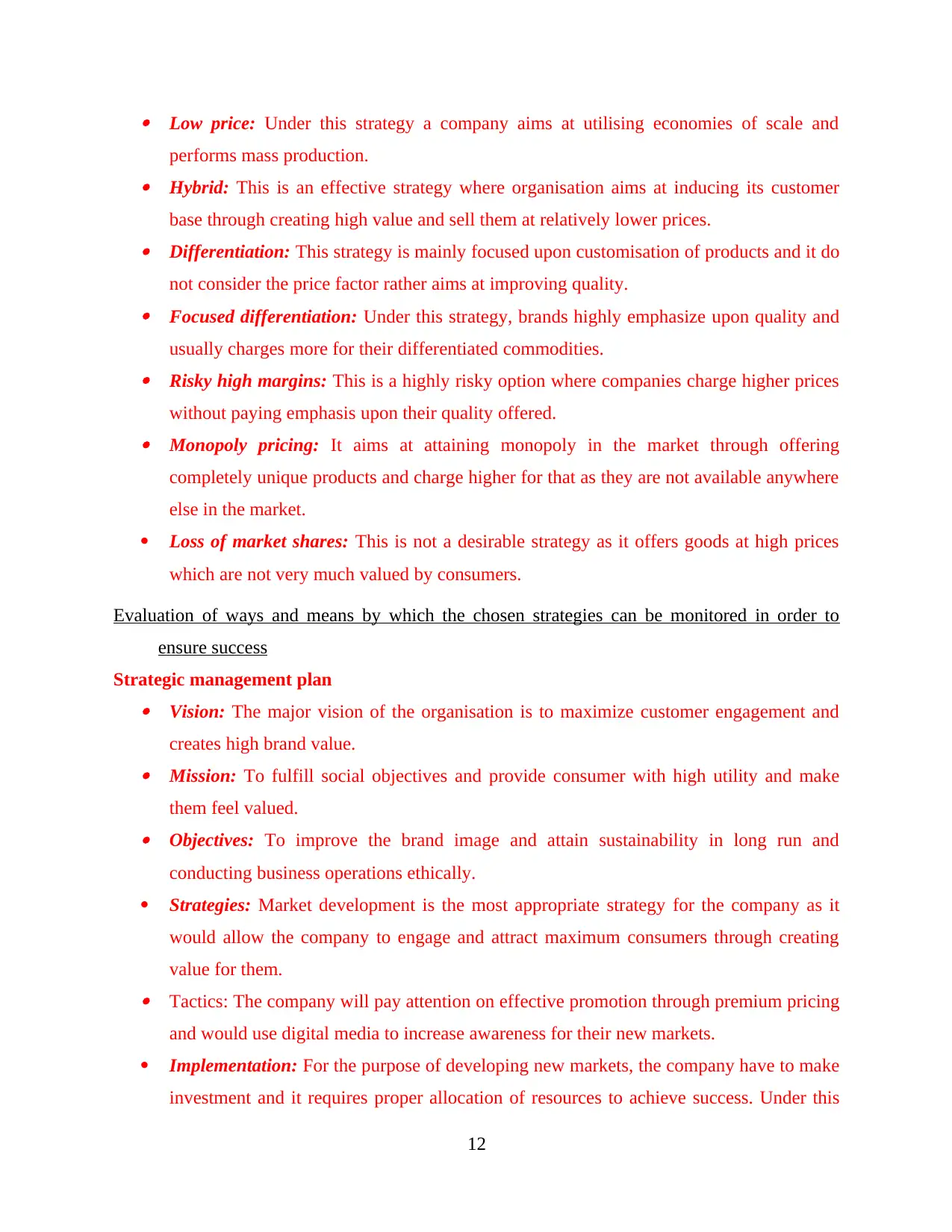
Low price: Under this strategy a company aims at utilising economies of scale and
performs mass production. Hybrid: This is an effective strategy where organisation aims at inducing its customer
base through creating high value and sell them at relatively lower prices. Differentiation: This strategy is mainly focused upon customisation of products and it do
not consider the price factor rather aims at improving quality. Focused differentiation: Under this strategy, brands highly emphasize upon quality and
usually charges more for their differentiated commodities. Risky high margins: This is a highly risky option where companies charge higher prices
without paying emphasis upon their quality offered. Monopoly pricing: It aims at attaining monopoly in the market through offering
completely unique products and charge higher for that as they are not available anywhere
else in the market.
Loss of market shares: This is not a desirable strategy as it offers goods at high prices
which are not very much valued by consumers.
Evaluation of ways and means by which the chosen strategies can be monitored in order to
ensure success
Strategic management plan Vision: The major vision of the organisation is to maximize customer engagement and
creates high brand value. Mission: To fulfill social objectives and provide consumer with high utility and make
them feel valued. Objectives: To improve the brand image and attain sustainability in long run and
conducting business operations ethically.
Strategies: Market development is the most appropriate strategy for the company as it
would allow the company to engage and attract maximum consumers through creating
value for them. Tactics: The company will pay attention on effective promotion through premium pricing
and would use digital media to increase awareness for their new markets.
Implementation: For the purpose of developing new markets, the company have to make
investment and it requires proper allocation of resources to achieve success. Under this
12
performs mass production. Hybrid: This is an effective strategy where organisation aims at inducing its customer
base through creating high value and sell them at relatively lower prices. Differentiation: This strategy is mainly focused upon customisation of products and it do
not consider the price factor rather aims at improving quality. Focused differentiation: Under this strategy, brands highly emphasize upon quality and
usually charges more for their differentiated commodities. Risky high margins: This is a highly risky option where companies charge higher prices
without paying emphasis upon their quality offered. Monopoly pricing: It aims at attaining monopoly in the market through offering
completely unique products and charge higher for that as they are not available anywhere
else in the market.
Loss of market shares: This is not a desirable strategy as it offers goods at high prices
which are not very much valued by consumers.
Evaluation of ways and means by which the chosen strategies can be monitored in order to
ensure success
Strategic management plan Vision: The major vision of the organisation is to maximize customer engagement and
creates high brand value. Mission: To fulfill social objectives and provide consumer with high utility and make
them feel valued. Objectives: To improve the brand image and attain sustainability in long run and
conducting business operations ethically.
Strategies: Market development is the most appropriate strategy for the company as it
would allow the company to engage and attract maximum consumers through creating
value for them. Tactics: The company will pay attention on effective promotion through premium pricing
and would use digital media to increase awareness for their new markets.
Implementation: For the purpose of developing new markets, the company have to make
investment and it requires proper allocation of resources to achieve success. Under this
12
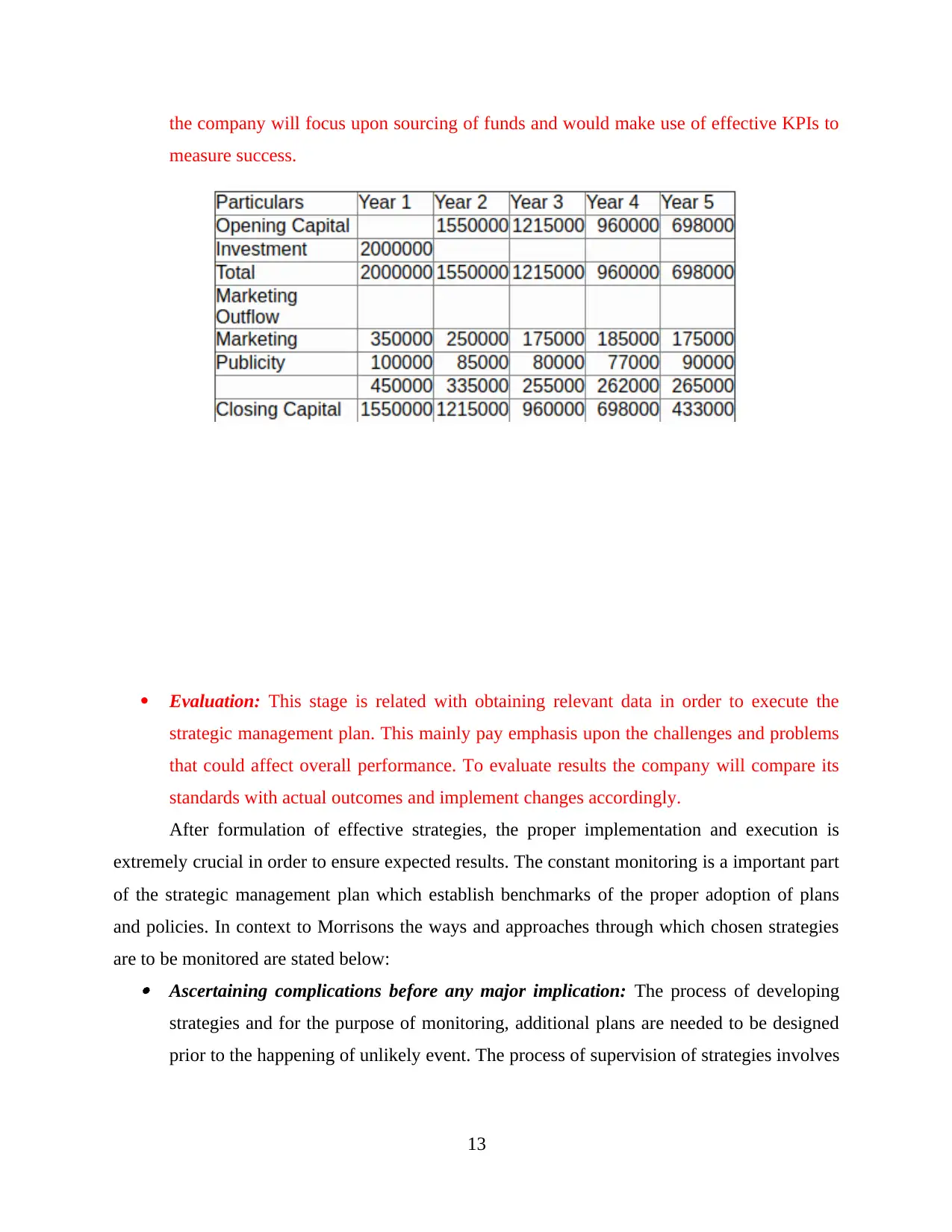
the company will focus upon sourcing of funds and would make use of effective KPIs to
measure success.
Evaluation: This stage is related with obtaining relevant data in order to execute the
strategic management plan. This mainly pay emphasis upon the challenges and problems
that could affect overall performance. To evaluate results the company will compare its
standards with actual outcomes and implement changes accordingly.
After formulation of effective strategies, the proper implementation and execution is
extremely crucial in order to ensure expected results. The constant monitoring is a important part
of the strategic management plan which establish benchmarks of the proper adoption of plans
and policies. In context to Morrisons the ways and approaches through which chosen strategies
are to be monitored are stated below: Ascertaining complications before any major implication: The process of developing
strategies and for the purpose of monitoring, additional plans are needed to be designed
prior to the happening of unlikely event. The process of supervision of strategies involves
13
measure success.
Evaluation: This stage is related with obtaining relevant data in order to execute the
strategic management plan. This mainly pay emphasis upon the challenges and problems
that could affect overall performance. To evaluate results the company will compare its
standards with actual outcomes and implement changes accordingly.
After formulation of effective strategies, the proper implementation and execution is
extremely crucial in order to ensure expected results. The constant monitoring is a important part
of the strategic management plan which establish benchmarks of the proper adoption of plans
and policies. In context to Morrisons the ways and approaches through which chosen strategies
are to be monitored are stated below: Ascertaining complications before any major implication: The process of developing
strategies and for the purpose of monitoring, additional plans are needed to be designed
prior to the happening of unlikely event. The process of supervision of strategies involves
13
Paraphrase This Document
Need a fresh take? Get an instant paraphrase of this document with our AI Paraphraser
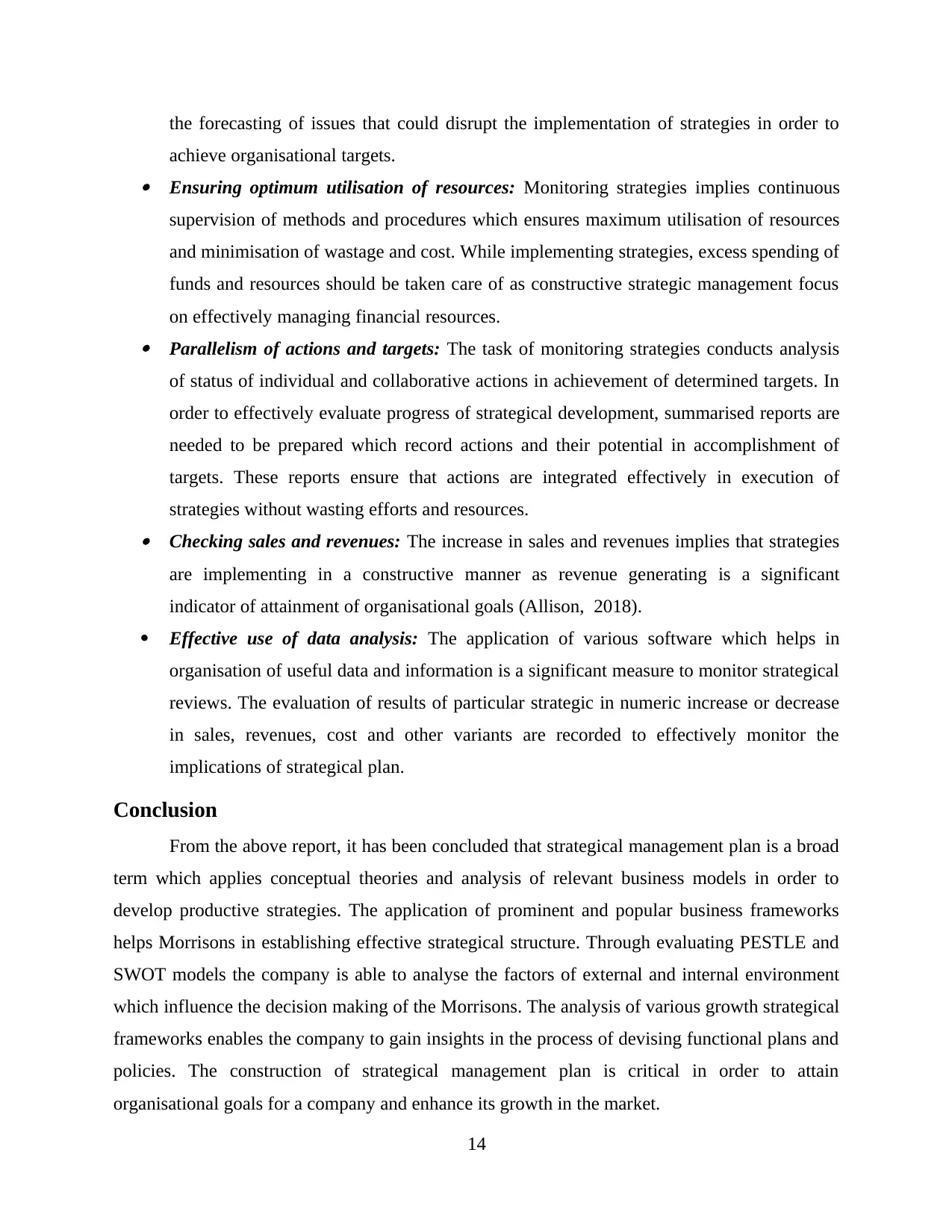
the forecasting of issues that could disrupt the implementation of strategies in order to
achieve organisational targets. Ensuring optimum utilisation of resources: Monitoring strategies implies continuous
supervision of methods and procedures which ensures maximum utilisation of resources
and minimisation of wastage and cost. While implementing strategies, excess spending of
funds and resources should be taken care of as constructive strategic management focus
on effectively managing financial resources. Parallelism of actions and targets: The task of monitoring strategies conducts analysis
of status of individual and collaborative actions in achievement of determined targets. In
order to effectively evaluate progress of strategical development, summarised reports are
needed to be prepared which record actions and their potential in accomplishment of
targets. These reports ensure that actions are integrated effectively in execution of
strategies without wasting efforts and resources. Checking sales and revenues: The increase in sales and revenues implies that strategies
are implementing in a constructive manner as revenue generating is a significant
indicator of attainment of organisational goals (Allison, 2018).
Effective use of data analysis: The application of various software which helps in
organisation of useful data and information is a significant measure to monitor strategical
reviews. The evaluation of results of particular strategic in numeric increase or decrease
in sales, revenues, cost and other variants are recorded to effectively monitor the
implications of strategical plan.
Conclusion
From the above report, it has been concluded that strategical management plan is a broad
term which applies conceptual theories and analysis of relevant business models in order to
develop productive strategies. The application of prominent and popular business frameworks
helps Morrisons in establishing effective strategical structure. Through evaluating PESTLE and
SWOT models the company is able to analyse the factors of external and internal environment
which influence the decision making of the Morrisons. The analysis of various growth strategical
frameworks enables the company to gain insights in the process of devising functional plans and
policies. The construction of strategical management plan is critical in order to attain
organisational goals for a company and enhance its growth in the market.
14
achieve organisational targets. Ensuring optimum utilisation of resources: Monitoring strategies implies continuous
supervision of methods and procedures which ensures maximum utilisation of resources
and minimisation of wastage and cost. While implementing strategies, excess spending of
funds and resources should be taken care of as constructive strategic management focus
on effectively managing financial resources. Parallelism of actions and targets: The task of monitoring strategies conducts analysis
of status of individual and collaborative actions in achievement of determined targets. In
order to effectively evaluate progress of strategical development, summarised reports are
needed to be prepared which record actions and their potential in accomplishment of
targets. These reports ensure that actions are integrated effectively in execution of
strategies without wasting efforts and resources. Checking sales and revenues: The increase in sales and revenues implies that strategies
are implementing in a constructive manner as revenue generating is a significant
indicator of attainment of organisational goals (Allison, 2018).
Effective use of data analysis: The application of various software which helps in
organisation of useful data and information is a significant measure to monitor strategical
reviews. The evaluation of results of particular strategic in numeric increase or decrease
in sales, revenues, cost and other variants are recorded to effectively monitor the
implications of strategical plan.
Conclusion
From the above report, it has been concluded that strategical management plan is a broad
term which applies conceptual theories and analysis of relevant business models in order to
develop productive strategies. The application of prominent and popular business frameworks
helps Morrisons in establishing effective strategical structure. Through evaluating PESTLE and
SWOT models the company is able to analyse the factors of external and internal environment
which influence the decision making of the Morrisons. The analysis of various growth strategical
frameworks enables the company to gain insights in the process of devising functional plans and
policies. The construction of strategical management plan is critical in order to attain
organisational goals for a company and enhance its growth in the market.
14
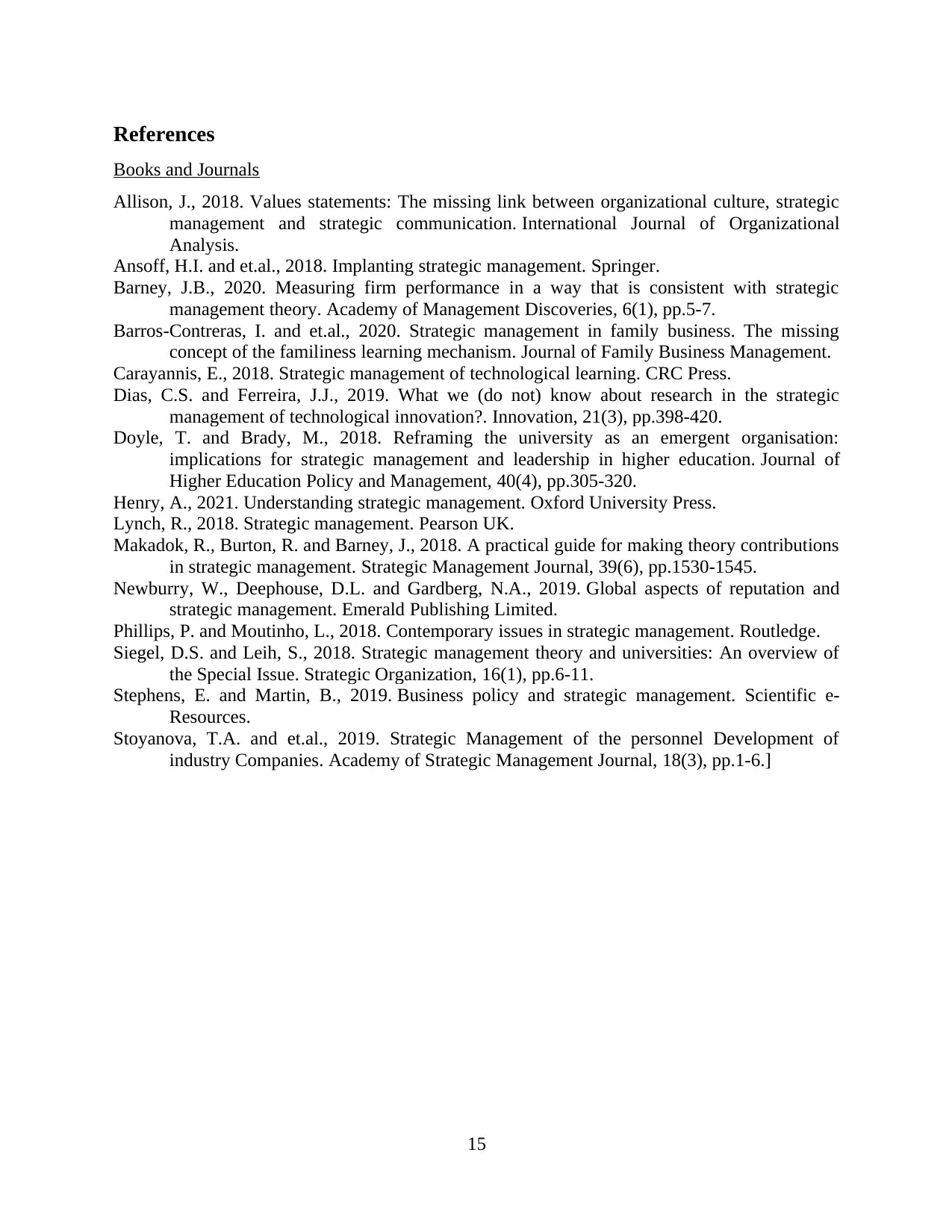
References
Books and Journals
Allison, J., 2018. Values statements: The missing link between organizational culture, strategic
management and strategic communication. International Journal of Organizational
Analysis.
Ansoff, H.I. and et.al., 2018. Implanting strategic management. Springer.
Barney, J.B., 2020. Measuring firm performance in a way that is consistent with strategic
management theory. Academy of Management Discoveries, 6(1), pp.5-7.
Barros-Contreras, I. and et.al., 2020. Strategic management in family business. The missing
concept of the familiness learning mechanism. Journal of Family Business Management.
Carayannis, E., 2018. Strategic management of technological learning. CRC Press.
Dias, C.S. and Ferreira, J.J., 2019. What we (do not) know about research in the strategic
management of technological innovation?. Innovation, 21(3), pp.398-420.
Doyle, T. and Brady, M., 2018. Reframing the university as an emergent organisation:
implications for strategic management and leadership in higher education. Journal of
Higher Education Policy and Management, 40(4), pp.305-320.
Henry, A., 2021. Understanding strategic management. Oxford University Press.
Lynch, R., 2018. Strategic management. Pearson UK.
Makadok, R., Burton, R. and Barney, J., 2018. A practical guide for making theory contributions
in strategic management. Strategic Management Journal, 39(6), pp.1530-1545.
Newburry, W., Deephouse, D.L. and Gardberg, N.A., 2019. Global aspects of reputation and
strategic management. Emerald Publishing Limited.
Phillips, P. and Moutinho, L., 2018. Contemporary issues in strategic management. Routledge.
Siegel, D.S. and Leih, S., 2018. Strategic management theory and universities: An overview of
the Special Issue. Strategic Organization, 16(1), pp.6-11.
Stephens, E. and Martin, B., 2019. Business policy and strategic management. Scientific e-
Resources.
Stoyanova, T.A. and et.al., 2019. Strategic Management of the personnel Development of
industry Companies. Academy of Strategic Management Journal, 18(3), pp.1-6.]
15
Books and Journals
Allison, J., 2018. Values statements: The missing link between organizational culture, strategic
management and strategic communication. International Journal of Organizational
Analysis.
Ansoff, H.I. and et.al., 2018. Implanting strategic management. Springer.
Barney, J.B., 2020. Measuring firm performance in a way that is consistent with strategic
management theory. Academy of Management Discoveries, 6(1), pp.5-7.
Barros-Contreras, I. and et.al., 2020. Strategic management in family business. The missing
concept of the familiness learning mechanism. Journal of Family Business Management.
Carayannis, E., 2018. Strategic management of technological learning. CRC Press.
Dias, C.S. and Ferreira, J.J., 2019. What we (do not) know about research in the strategic
management of technological innovation?. Innovation, 21(3), pp.398-420.
Doyle, T. and Brady, M., 2018. Reframing the university as an emergent organisation:
implications for strategic management and leadership in higher education. Journal of
Higher Education Policy and Management, 40(4), pp.305-320.
Henry, A., 2021. Understanding strategic management. Oxford University Press.
Lynch, R., 2018. Strategic management. Pearson UK.
Makadok, R., Burton, R. and Barney, J., 2018. A practical guide for making theory contributions
in strategic management. Strategic Management Journal, 39(6), pp.1530-1545.
Newburry, W., Deephouse, D.L. and Gardberg, N.A., 2019. Global aspects of reputation and
strategic management. Emerald Publishing Limited.
Phillips, P. and Moutinho, L., 2018. Contemporary issues in strategic management. Routledge.
Siegel, D.S. and Leih, S., 2018. Strategic management theory and universities: An overview of
the Special Issue. Strategic Organization, 16(1), pp.6-11.
Stephens, E. and Martin, B., 2019. Business policy and strategic management. Scientific e-
Resources.
Stoyanova, T.A. and et.al., 2019. Strategic Management of the personnel Development of
industry Companies. Academy of Strategic Management Journal, 18(3), pp.1-6.]
15

16
1 out of 16
Related Documents
Your All-in-One AI-Powered Toolkit for Academic Success.
+13062052269
info@desklib.com
Available 24*7 on WhatsApp / Email
![[object Object]](/_next/static/media/star-bottom.7253800d.svg)
Unlock your academic potential
© 2024 | Zucol Services PVT LTD | All rights reserved.




